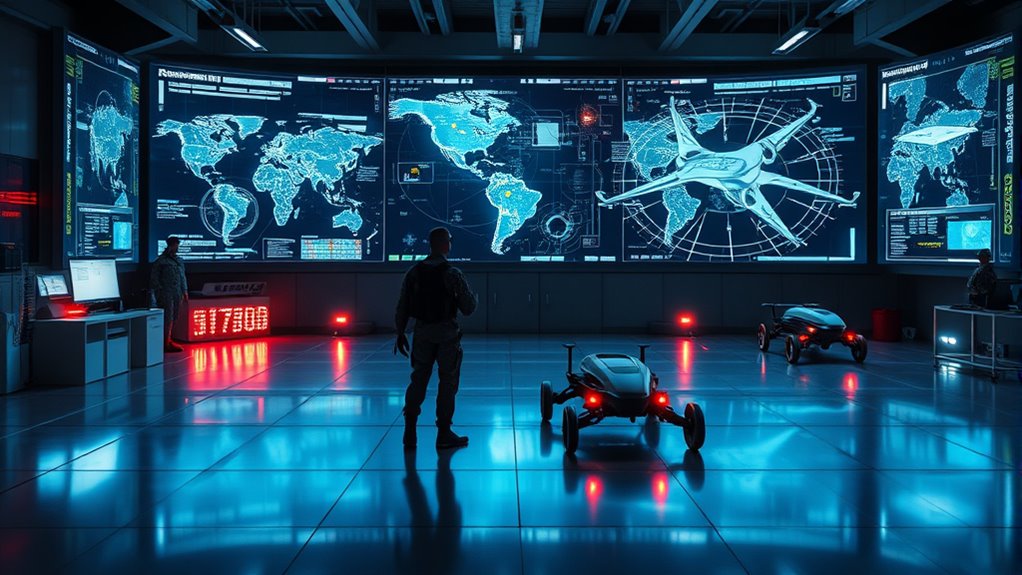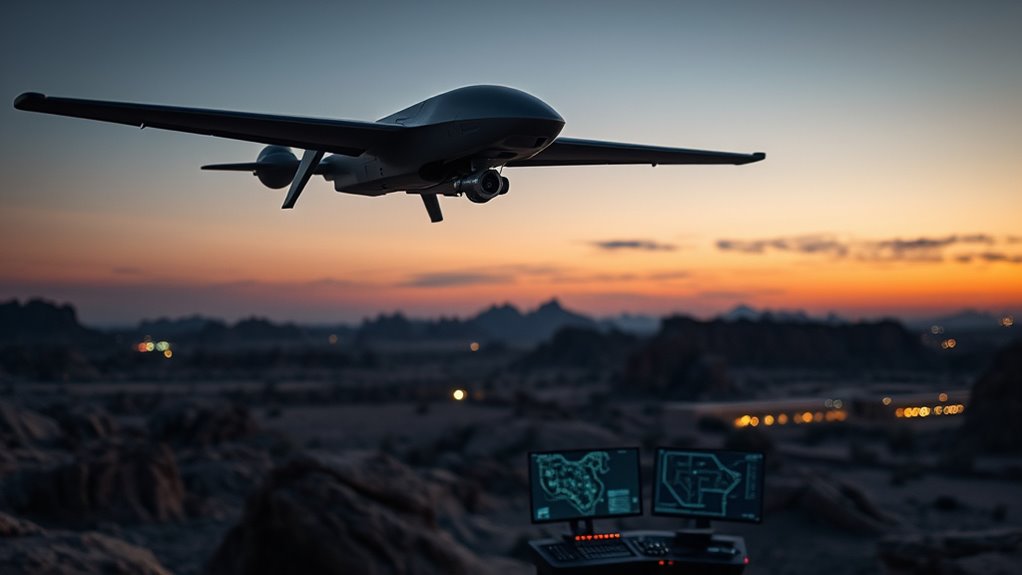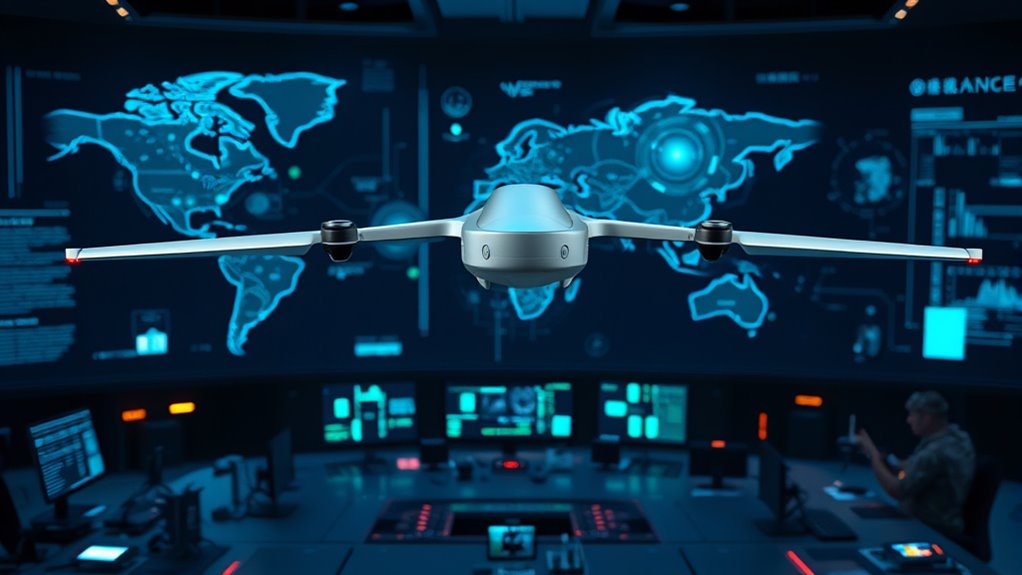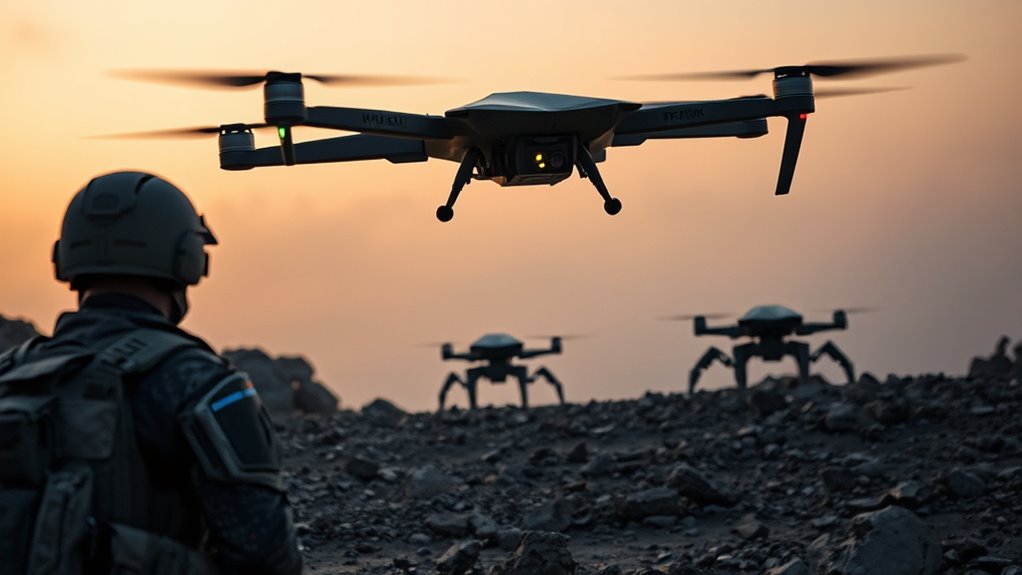AI in military and defense is rapidly advancing with autonomous weapons systems like drones and missile defense platforms that improve speed and accuracy. These technologies offer strategic benefits but also bring ethical, legal, and proliferation risks. International cooperation and regulation are essential to guarantee responsible use and prevent misuse by rogue actors. To understand how these developments shape future warfare and global stability, explore how AI-driven strategies are evolving worldwide.
Key Takeaways
- Autonomous weapons, such as drones and missile systems, enhance speed and precision in military operations, reducing human risk.
- International efforts focus on regulations, treaties, and ethical frameworks to manage proliferation and responsible deployment of military AI.
- Advances in AI enable faster decision-making and battlefield agility but raise concerns about accountability and escalation risks.
- Autonomous systems’ proliferation and low cost increase the threat of illicit trade and misuse by non-state actors and regimes.
- Future military AI trends include increased autonomy, larger operational scopes, and the need for transparent, ethical governance.
Market Growth and Investment in Military AI Technologies

The global military AI market is experiencing rapid growth driven by increasing investments and technological advancements. You’ll notice that market revenues jumped from USD 7.9 billion in 2022 to USD 9.8 billion in 2024, and by 2025, it’s projected to reach USD 11.4 billion. This expansion reflects strong commitment from governments and defense contractors to develop smarter, more capable systems. The market’s growth rate, at a CAGR of 12.4%, indicates sustained momentum through 2032, with total value expected to hit USD 24.7 billion. Autonomous weapons play a significant role in this trend, fueling demand for advanced AI solutions. As investment continues to increase, expect more cutting-edge innovations to reshape military capabilities and strategic planning worldwide. Ongoing AI security concerns highlight the importance of balancing technological advancement with safety measures in military applications. Moreover, integrating autonomous systems more effectively can enhance operational efficiency and decision-making, further accelerating market growth. The emphasis on machine learning algorithms demonstrates how ongoing research is vital for improving autonomous weapon systems and strategic responses. Additionally, advancements in cybersecurity are crucial to protect these sophisticated systems from emerging threats. Continuous development in ethical frameworks is also gaining importance to ensure responsible deployment of military AI technologies.
Key Autonomous Weapons Systems and Technological Advances

Autonomous weapons systems are rapidly advancing, driven by breakthroughs in AI and robotics. These technologies are transforming modern warfare, making systems more lethal and efficient. You should know about:
- Missile Defense Platforms: Systems like Israel’s Iron Dome and the U.S. Phalanx can detect, track, and intercept threats automatically, saving lives and preventing damage. Improved target identification capabilities enhance their effectiveness in complex combat environments. As these systems become more sophisticated, their ability to adapt to dynamic threats continues to improve.
- Autonomous Drones: These drones fly missions independently, searching for targets and engaging without human input, increasing operational reach and precision.
- Loitering Munitions: Combining surveillance and attack, they hover over targets for hours before striking, providing real-time adaptability and reducing risk to personnel. The integration of AI algorithms allows for better decision-making in complex scenarios.
- Advances in AI are pushing these weapons toward full autonomy, raising strategic and ethical questions about their use and control. Self-awareness is a crucial factor in understanding how autonomous systems can evolve and be managed responsibly.
Operational Benefits and Strategic Advantages of AI Integration

Integrating AI into military operations offers significant strategic advantages by enhancing decision speed, precision, and adaptability. You can process vast amounts of data rapidly, enabling quicker responses to threats and changing battlefield conditions. AI-driven systems improve targeting accuracy, reducing collateral damage and increasing mission success rates. They also allow for real-time adjustments, making tactics more flexible and resilient against adversaries. Autonomous weapons and decision support tools increase operational efficiency, freeing human soldiers from routine tasks and enabling focus on complex strategic planning. This integration enhances situational awareness, providing commanders with all-encompassing battlefield insights. Additionally, natural language processing can be utilized to analyze intelligence reports and communication, further optimizing strategic decision-making. As a result, you gain a competitive edge by making faster, more informed decisions, ultimately strengthening your military’s effectiveness and strategic posture in dynamic conflict scenarios.
Ethical and Legal Challenges of Autonomous Targeting

As autonomous targeting systems make decisions without direct human input, ethical and legal challenges quickly arise. You’re faced with dilemmas about accountability when machines misidentify targets or cause unintended harm. These systems can make mistakes, risking civilian lives and violating international laws. Consider these critical issues:
1. Loss of human control—machines might act unpredictably, reducing accountability for lethal decisions. Incorporating ethical considerations into design and deployment processes can help mitigate some risks associated with autonomous systems. Additionally, establishing clear accountability frameworks is crucial to address legal uncertainties and ensure responsible use of autonomous weapons. Recognizing the importance of autonomous decision-making policies can further guide responsible development and deployment of these systems. Moreover, understanding international law implications is essential to navigate the complex legal landscape surrounding autonomous military technologies. Implementing regulatory measures can further enhance compliance and safety standards across different jurisdictions.
Risks of Proliferation and Black Market Trade of Autonomous Weapons

The proliferation of autonomous weapons raises serious concerns beyond ethical and legal debates, especially regarding their spread through illegal markets. These systems are inexpensive, portable, and difficult to track, making them attractive for black market trade. Such proliferation increases risks of terrorism, oppressive regimes, and non-state actors acquiring lethal capabilities. To highlight this, consider the table:
| Risk | Explanation |
|---|---|
| Black Market Trade | Easier to smuggle and sell autonomous weapons illicitly. |
| Terrorism | Access to autonomous weapons amplifies attack potential. |
| Regime Misuse | Authoritarian regimes may deploy weapons without oversight. |
| Unregulated Markets | Lack of controls fosters proliferation. |
| Global Security Threats | Widespread availability destabilizes international security. |
Without tighter controls, these threats will escalate, undermining global stability. Additionally, the sound development of regulations and oversight mechanisms is critical to prevent the further spread of these dangerous technologies. Strengthening regulatory frameworks can help mitigate these risks before they become unmanageable. Addressing illicit trafficking routes is also essential to curbing the illegal distribution of autonomous weapons. Furthermore, establishing international cooperation is crucial to effectively combat the proliferation networks involved. Moreover, enhancing intelligence sharing between nations can improve efforts to detect and dismantle illicit networks involved in autonomous weapon trade.
Impact on Warfare Strategies and Command Structures

Autonomous weapons and AI-driven decision systems are transforming warfare strategies and command structures by enabling faster, more precise operations. You’ll notice military decision-making shifting from lengthy deliberations to rapid, automated responses, reducing the time from threat detection to action. This shift can evoke powerful emotions, such as:
Autonomous systems accelerate decision-making, transforming warfare with faster, more precise, but riskier operations.
- Increased battlefield agility, allowing forces to adapt swiftly to changing scenarios and gain the upper hand.
- Heightened risks of miscalculation, as rapid decision cycles may lead to unintended escalation or mistakes.
- Evolving command hierarchies, where humans work alongside AI systems, creating new dynamics of control and responsibility.
- The integration of subconscious influence, where operators’ perceptions and instincts may be affected by rapid decision-making processes and AI feedback loops.
- The importance of ethical considerations in deploying autonomous systems, which is crucial for maintaining international stability and trust. Additionally, understanding how public perception influences policy decisions is vital for responsible AI deployment in military contexts.
- The increasing reliance on technological innovation to stay ahead in modern warfare underscores the need for comprehensive strategies to manage these advancements responsibly.
These changes make warfare more dynamic but also demand careful management to prevent chaos and maintain strategic stability.
Human Oversight, Accountability, and Legal Responsibilities

The rapid decision-making capabilities of AI-driven military systems raise significant questions about human oversight, accountability, and legal responsibility. You must guarantee meaningful human control to prevent unintended harm and maintain compliance with international laws. When autonomous systems select or engage targets, the chain of accountability can become unclear, making it difficult to assign responsibility for mistakes or violations. You need clear protocols and oversight mechanisms to intervene or override autonomous actions when necessary. Legal responsibilities often fall into a gray area, especially when machines act independently. As AI advances, you must develop frameworks that define who is accountable—be it developers, commanders, or political leaders—and ensure transparency in decision processes to uphold ethical standards and international commitments. Additionally, implementing secure payment processing and other technological safeguards can help mitigate risks associated with autonomous military operations. Ensuring accountability structures are in place is essential for maintaining trust and adherence to legal standards in these complex scenarios.
International Dialogue and Regulatory Efforts

How can the international community effectively regulate the rapidly evolving field of military AI and autonomous weapons? You face a complex challenge: ensuring safety, ethics, and stability while preventing misuse. To do this, consider these critical steps:
- Establish binding international treaties that limit or ban lethal autonomous weapons, holding nations accountable.
- Create transparent verification mechanisms to monitor compliance and build trust among countries.
- Foster ongoing global dialogue involving governments, tech companies, and civil society to develop shared standards and ethical frameworks.
These efforts can prevent an arms race, reduce risks of conflict escalation, and protect human rights. Your active engagement shapes a safer, more responsible future for military AI governance.
Future Outlook and Emerging Trends in Military AI

Advancements in military AI are poised to reshape future warfare, bringing both transformative opportunities and significant challenges. You can expect continued growth in autonomous systems, with faster decision-making and enhanced operational efficiency. Emerging trends include the development of fully autonomous weapons capable of operating across larger areas and longer durations, as well as sophisticated decision support tools that augment human judgment. However, these innovations also raise concerns about unpredictability, escalation risks, and proliferation. As technology advances, international cooperation will become increasingly crucial to establish norms and regulations, ensuring responsible use. You should also watch for ethical debates intensifying around accountability and moral decision-making, which will influence policy and deployment. Overall, the future of military AI promises strategic advantages but demands careful oversight to mitigate risks.
Frequently Asked Questions
How Does Autonomous Weapon Behavior Vary Across Different Operational Environments?
You’ll notice that autonomous weapon behavior changes depending on the operational environment. In complex, unpredictable settings like urban areas, these systems may struggle with target identification, increasing the risk of mistakes. In open, stable terrains, they perform more reliably, executing tasks with precision. However, environmental factors like weather or electromagnetic interference can disrupt sensor data, causing unpredictable actions and raising concerns about safety, control, and ethical use.
What Measures Are in Place to Prevent Autonomous Weapons From Malfunctioning?
You might think autonomous weapons are foolproof, but they can malfunction, so strict measures are in place. You’ll find that human oversight remains critical, with protocols like kill switches and continuous testing to prevent errors. Developers also implement rigorous validation, real-time monitoring, and fail-safes to catch glitches early. These steps aim to guarantee safety, minimize unintended harm, and keep control firmly in human hands, preventing dangerous malfunctions.
How Do Autonomous Systems Prioritize Targets in Complex Combat Scenarios?
You should know that autonomous systems prioritize targets based on programmed algorithms, sensor data, and AI decision-making processes. They analyze factors like threat level, target identification, and environmental conditions to select what to engage. However, in complex combat scenarios, their prioritization can be unpredictable due to the dynamic environment and machine learning interactions. Human oversight remains vital to guarantee correct target selection and prevent unintended consequences.
What Are the Privacy Implications of Biometric Data Used in Autonomous Targeting?
You should be aware that using biometric data in autonomous targeting raises serious privacy concerns. It involves collecting and analyzing personal information, often without consent, which can lead to misuse, surveillance, or discrimination. This data could be exploited by malicious actors or oppressive regimes, risking violations of individual rights. Ensuring strict data protection and transparency is essential to prevent abuses and uphold privacy standards in military applications.
How Can International Law Adapt to Emerging Autonomous Weapon Technologies?
You can expect international law to adapt by establishing clear regulations on autonomous weapons, emphasizing human oversight, and defining accountability standards. New treaties may ban or restrict fully autonomous lethal systems, while existing frameworks like the Geneva Conventions could expand to address AI-specific concerns. Countries must collaborate to create transparent, enforceable rules that balance technological advancement with ethical considerations, ensuring responsible use and minimizing risks of misuse or escalation.
Conclusion
As military AI investments soar, the market is expected to reach $18.2 billion by 2026, transforming warfare. You must stay informed about the ethical, legal, and strategic challenges these technologies pose. While autonomous weapons offer unmatched speed and precision, they also raise concerns about accountability and proliferation. Embracing responsible development and international cooperation is essential. The future of military AI hinges on balancing innovation with safety—your role in shaping this landscape is more important than ever.










